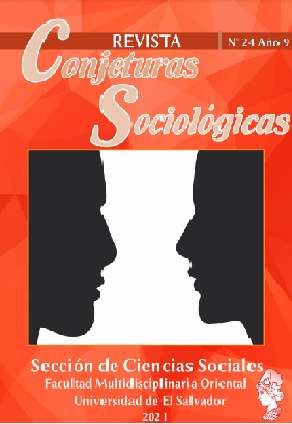Planetary health in the anthropecene
Keywords:
Socio-ecological systems, complexity, resilience, anthropocene, environment, adaptive system, biodiversity, zoonosis, planetary healthAbstract
The search for material well-being began to consolidate at the end of the 18th century with a broad process of economic, socio-environmental transformation, beginning the First Industrial Revolution, the so-called Great Acceleration began. This economic development increased the quality of life by improving access to material goods, access to health and education in many regions of the world. As a product of this great acceleration, all these global changes are leading the planet to an imbalance in biotic and non-biotic systems, which have been leaving traces in biogeochemical processes, which has led to the proposal of a new geological era. after the Holocene, called the Anthropocene. Socio-ecological systems are being degraded at an accelerating rate. All of this is interconnected and interdependent, its complex causality reflected in such a way that if one part is disturbed, it has consequences on the other part, which in turn influences the first. The inflection points or planetary limits are already being exceeded, humanity should maintain itself so as not to cross the threshold that triggers an abrupt and non-linear environmental change within the continental to planetary scale systems. Environmental health and human health are parts of the same system. Zoonotic diseases represent more than 60 percent of emerging diseases today and 75% of new infectious diseases are zoonotic, passing from animals to humans, which shows the close interconnection between the health of the planet and the Human health. These are not random events, they reflect patterns of what we are doing, the destruction of the habitat of many reservoir hosts has resulted in them being more directly related to human populations. Disruption and connectivity are two of the factors that make zoonotic diseases more threatening, more severe, and less preventable. The importance of maintaining protected areas for the conservation of biodiversity and the preservation of eco-systemic services, which favors the “dilution” effect of many diseases that affect other species and that have the ability to “spill over” onto communities human. As well as facing decarbonization at all levels, protecting watersheds and urgently addressing sustainable consumption and production, and preventing and managing disaster risk.Downloads
References
i- https://es.wikipedia.org/wiki/RevoluciC3%B3n_Industrial (consultado el 5 octubre 2020)
ii- Foro Económico Mundial & PwC Serie Nueva Economía Natural (Enero de 2020) Incremento de los riesgos naturales: Por qué la crisis que está engullendo la naturaleza es importante para la empresa y la economía. En colaboración con PwC enero de 2020. Foro Económico Mundial 91-93 route de la Capite CH-1223 Cologny/Ginebra Suiza.
iii- Rockström, Johan, Mattias Klum and Peter Miller (2015) Big world small planet. Abundance with planetary boundaries. Yale University Press. New Haven and London.
iv- Naciones Unidas (2020) Informe de los Objetivos de Desarrollo Sostenible 2020. Publicación de las Naciones Unidas emitida por el Departamento de Asuntos Económicos y Sociales (DESA) e-ISBN: 978-92-1-004963-4
v- División de Población de Naciones Unidas (junio 2019) Perspectivas de la Población Mundial 2019: Aspectos Destacados. División de Población del Departamento de Asuntos Económicos y Sociales de las Naciones Unidas.
vi- http://www.igbp.net/about/history.4.1b8ae20512db692f2a680001291.html (consultado el 5 octubre 2020)
vii- Crutzen P.J. (2006) The “Anthropocene”. Ehlers E., Krafft T. (eds) Earth System Science in the Anthropocene. Springer, Berlin, Heidelberg. https://doi.org/10.1007/3-540-26590-2_3
viii- https://www.noaa.gov/news/earth-just-had-its-hottest-september-on-record
ix- Thomson, Andrea (October 9, 2020) A Running List of Record-Breaking Natural Disasters in 2020. The year has already seen many extremes, from California’s and Colorado’s largest wildfires to a tropical cyclone boom. Scientific American. Natural Disasters. https://www.scientificamerican.com/natural-disasters/
x- Walton, Dan and Maarten van Aalst (September 2020) Climate-related extreme weather events and COVID-19. A first look at the number of people affected by intersecting disasters. FRC and the Red Cross Red Crescent Climate Centre, September 2020.
xi- Ceballos, Gerardo; Paul R. Ehrlich, Peter H. Raven (2017) Vertebrates on the brink as indicators of biological annihilation and the sixth mass extinction.
Proceedings of the National Academy of Sciences Jun 2020, 117 (24) 13596-13602; DOI: 10.1073/pnas.1922686117
xii- Programa de las Naciones Unidas para el Medio Ambiente (2019), Perspectivas del Medio Ambiente Mundial, GEO 6: Planeta sano, personas sanas. Nairobi. Sección de Servicios de publicaciones, ONUN, Nairobi, certificado ISO 14001.
xiii- Prüss-Ustün A, Wolf J, Corvalán C, Bos R, Neira M. (2016) Preventing disease through healthy environments: A global assessment of the environmental burden of disease from environmental risks. Ginebra: Organización Mundial de la Salud.
xiv- Rockström, J., W. Steffen, K. Noone, Å. Persson, F. S. Chapin, III, E. Lambin, T. M. Lenton, M. Scheffer, C. Folke, H. Schellnhuber, B. Nykvist, C. A. De Wit, T. Hughes, S. van der Leeuw, H. Rodhe, S. Sörlin, P. K. Snyder, R. Costanza, U. Svedin, M. Falkenmark, L. Karlberg, R. W. Corell, V. J. Fabry, J. Hansen, B. Walker, D. Liverman, K. Richardson, P. Crutzen, and J. Foley. 2009. Planetary boundaries: exploring the safe operating space for humanity. Ecology and Society 14(2): 32. [online] URL: http://www.ecologyandsociety.org/vol14/iss2/art32/
xv- Will Steffen, Johan Rockström, Katherine Richardson, Timothy M. Lenton, Carl Folke, Diana Liverman, Colin P. Summerhayes, Anthony D. Barnosky, Sarah E. Cornell, Michel Crucifix, Jonathan F. Donges, Ingo Fetzer, Steven J. Lade, Marten, Scheffer, Ricarda Winkelmann, and Hans Joachim Schellnhuber (2018) Trajectories of the Earth System in the Anthropocene. PNAS August 14, 2018 115 (33) 8252-8259; first published August 6, 2018; https://doi.org/10.1073/pnas.1810141115. Edited by William C. Clark, Harvard University, Cambridge, MA, and approved July 6, 2018 (received for review June 19, 2018)
xvi- Op. Cit. Programa de las Naciones Unidas para el Medio Ambiente, 2019.
Published
How to Cite
Issue
Section
License
Copyright (c) 2021 Laura Rathe Peralta

This work is licensed under a Creative Commons Attribution-NonCommercial 4.0 International License.
Los autores continúan como propietarios de sus trabajos, cediendo de manera no exclusiva los derechos de difusión a la Revista Conjeturas Sociológicas bajo los estándares de la Licencia Creative Commons Atribución No Comercial 4.0 Internacional (CC BY NC 4.0).





